The Impact of Changes in Couples' Earnings on Married Women's Social Security Benefits
Social Security Bulletin, Vol. 72, No. 1, 2012 (released February 2012)
Women's labor force participation and earnings dramatically increased after World War II. Those changes have important implications for women's Social Security benefits. This article uses the Social Security Administration's Modeling Income in the Near Term (version 6) to examine Social Security benefits for current and future beneficiary wives. The projections show that fewer wives in more recent birth cohorts will be eligible for auxiliary benefits as spouses because their earnings are too high. If their husbands die, however, most wives will still be eligible for survivor benefits because, despite the increase in their earnings over time, they still typically have lower earnings than their husbands. Even so, the share of wives who would be ineligible for widow benefits is projected to double between cohorts.
Barbara Butrica and Karen Smith are senior research associates at the Urban Institute.
Acknowledgments: The authors are grateful for helpful comments from Joni Lavery and Chris Tamborini at the Social Security Administration.
This research was funded by the Social Security Administration (contract no. SS00-06-60113 and order no. SS00-10-31234).
Contents of this publication are not copyrighted; any items may be reprinted, but citation of the Social Security Bulletin as the source is requested. The findings and conclusions presented in the Bulletin are those of the authors and do not necessarily represent the views of the Social Security Administration or the Urban Institute, its trustees, or funders.
Introduction
| GenX | generation X |
| MINT6 | Modeling Income in the Near Term, version 6 |
| PIA | primary insurance amount |
Women today are more likely than their mothers and grandmothers to work and to have higher earnings when they do work. Although women's labor force participation had been slowly but steadily rising since the late 1800s, the majority of women did not work and those who did work tended to be unmarried, less educated, and poor (Goldin 2006). From the 1950s through the 1990s, women's labor force participation soared as married women, older women, and those with more education and vocational training entered the labor market (Blau and Kahn 2007; Devereux 2004; Goldin 2006). Since then, the growth in women's labor supply has slowed dramatically, leaving some researchers to speculate whether women's participation in the labor force has reached its "natural rate" (Goldin 2006). Between 1950 and 2010, labor force participation rates for women aged 25–54 doubled, from 37 percent to 75 percent (Chart 1). In contrast, labor force participation rates for men in the same age group declined by 8 percent during this period, from 97 percent down to 89 percent. The trends in work are even more dramatic for persons aged 55–64, increasing by 122 percent for women and declining by 20 percent for men (Bureau of Labor Statistics 2011).
Labor force participation rates of men and women, 1950–2010
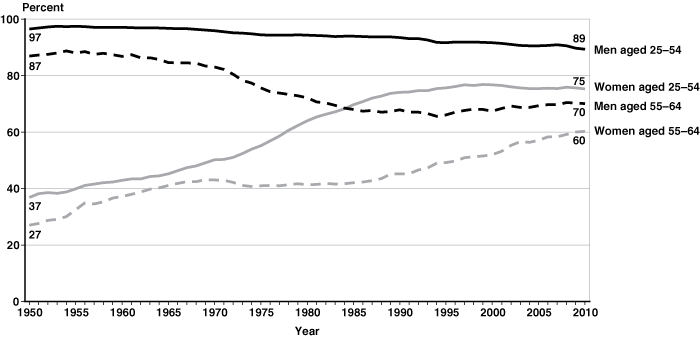
| Year | Men aged 25–54 |
Women aged 25–54 |
Men aged 55–64 |
Women aged 55–64 |
|---|---|---|---|---|
| 1950 | 97 | 37 | 87 | 27 |
| 1951 | 97 | 38 | 87 | 28 |
| 1952 | 97 | 39 | 88 | 29 |
| 1953 | 97 | 38 | 88 | 29 |
| 1954 | 97 | 39 | 89 | 30 |
| 1955 | 97 | 40 | 88 | 33 |
| 1956 | 97 | 41 | 89 | 35 |
| 1957 | 97 | 42 | 88 | 35 |
| 1958 | 97 | 42 | 88 | 35 |
| 1959 | 97 | 42 | 87 | 37 |
| 1960 | 97 | 43 | 87 | 37 |
| 1961 | 97 | 43 | 87 | 38 |
| 1962 | 97 | 43 | 86 | 39 |
| 1963 | 97 | 44 | 86 | 40 |
| 1964 | 97 | 45 | 86 | 40 |
| 1965 | 97 | 45 | 85 | 41 |
| 1966 | 97 | 46 | 85 | 42 |
| 1967 | 97 | 47 | 84 | 42 |
| 1968 | 96 | 48 | 84 | 42 |
| 1969 | 96 | 49 | 83 | 43 |
| 1970 | 96 | 50 | 83 | 43 |
| 1971 | 96 | 50 | 82 | 43 |
| 1972 | 95 | 51 | 80 | 42 |
| 1973 | 95 | 52 | 78 | 41 |
| 1974 | 95 | 54 | 77 | 41 |
| 1975 | 94 | 55 | 76 | 41 |
| 1976 | 94 | 57 | 74 | 41 |
| 1977 | 94 | 59 | 74 | 41 |
| 1978 | 94 | 61 | 73 | 41 |
| 1979 | 94 | 62 | 73 | 42 |
| 1980 | 94 | 64 | 72 | 41 |
| 1981 | 94 | 65 | 71 | 41 |
| 1982 | 94 | 66 | 70 | 42 |
| 1983 | 94 | 67 | 69 | 42 |
| 1984 | 94 | 68 | 69 | 42 |
| 1985 | 94 | 70 | 68 | 42 |
| 1986 | 94 | 71 | 67 | 42 |
| 1987 | 94 | 72 | 68 | 43 |
| 1988 | 94 | 73 | 67 | 44 |
| 1989 | 94 | 74 | 67 | 45 |
| 1990 | 93 | 74 | 68 | 45 |
| 1991 | 93 | 74 | 67 | 45 |
| 1992 | 93 | 75 | 67 | 47 |
| 1993 | 93 | 75 | 67 | 47 |
| 1994 | 92 | 75 | 66 | 49 |
| 1995 | 92 | 76 | 66 | 49 |
| 1996 | 92 | 76 | 67 | 50 |
| 1997 | 92 | 77 | 68 | 51 |
| 1998 | 92 | 77 | 68 | 51 |
| 1999 | 92 | 77 | 68 | 52 |
| 2000 | 92 | 77 | 67 | 52 |
| 2001 | 91 | 76 | 68 | 53 |
| 2002 | 91 | 76 | 69 | 55 |
| 2003 | 91 | 76 | 69 | 57 |
| 2004 | 91 | 75 | 69 | 56 |
| 2005 | 91 | 75 | 69 | 57 |
| 2006 | 91 | 76 | 70 | 58 |
| 2007 | 91 | 75 | 70 | 58 |
| 2008 | 91 | 76 | 70 | 59 |
| 2009 | 90 | 76 | 70 | 60 |
| 2010 | 89 | 75 | 70 | 60 |
Married women in particular experienced the largest gains in labor force participation rates during the 1950–2010 period (Census Bureau 2011, Table 596). As a result, dual-earner couples are becoming more commonplace. Between 1980 and 2010, the proportion of married couples with both spouses in the labor force increased from 46 percent to 54 percent (Census Bureau 1981, Table 6; Census Bureau 2010, Table FG1).
As women have increased their participation in the labor market, their earnings have also increased. Median wage and salary income in 2010 dollars increased steadily for women in Social Security–covered employment, from $7,352 in 1940 to $21,323 in 2008 (Chart 2). In contrast, men's earnings peaked in 1970 at $34,732; declined steadily through 1995; and then increased slightly to $30,690 in 2008 (SSA 2011, Table 4.B3). Because of those trends, men's earnings were twice as high as women's earnings in 1940, rising to 2.5 times as high in 1955, but only 1.4 times as high as women's earnings in 2008.
Median wage and salary earnings of men and women in Social Security–covered employment, 1940–2008
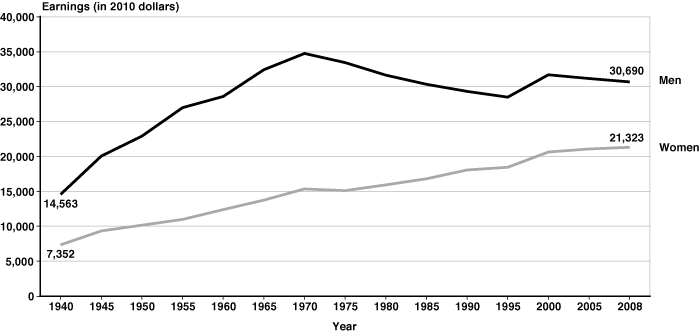
| Year | Men | Women |
|---|---|---|
| 1940 | 14,563 | 7,352 |
| 1945 | 20,037 | 9,328 |
| 1950 | 22,909 | 10,170 |
| 1955 | 26,972 | 10,992 |
| 1960 | 28,576 | 12,369 |
| 1965 | 32,432 | 13,734 |
| 1970 | 34,732 | 15,371 |
| 1975 | 33,438 | 15,118 |
| 1980 | 31,658 | 15,910 |
| 1985 | 30,315 | 16,806 |
| 1990 | 29,333 | 18,080 |
| 1995 | 28,483 | 18,453 |
| 2000 | 31,698 | 20,624 |
| 2005 | 31,135 | 21,087 |
| 2008 | 30,690 | 21,323 |
Increased female labor force participation and earnings coupled with declining male labor force participation and earnings have altered the correlation between husbands' and wives' earnings. Schwartz (2010) found the earnings of husbands and wives to be negatively correlated in the late 1960s and 1970s, reflecting the choice of women married to higher-earning husbands to be full-time mothers. By the mid-2000s, the correlation between spouses' earnings had become positive, reflecting men's and women's increasing preference for spouses with similar earnings (Schwartz 2010; Sweeney and Cancian 2004). Schwartz (2010) estimated that increases in married couples' earnings inequality between 1967 and 2005 would have been 25 percent to 30 percent lower had spouses' earnings not increased in their correlation. As women's labor force participation and earnings have increased, married women's own-wage and cross-wage labor supply elasticities have become more like those of married men, meaning that married women's labor supply is less responsive to changes in their own wages and changes in their husband's wages (Blau and Kahn 2007).
Social Security benefits, which nearly a third of beneficiaries aged 65 or older depend on for 90 percent or more of their total income, are programmatically linked to both marital and earnings histories (SSA 2010, Table 9.A1). There is no doubt that the trends in work and earnings described earlier will affect Social Security benefits. This article uses projections from a microsimulation model to estimate the impact of those trends on the Social Security benefits of future cohorts of married retirees.
Social Security Program Rules
Social Security pays retired-worker benefits to workers who have 40 quarters of earnings in covered employment over their lives. Those benefits are computed by indexing annual earnings over a person's working life and then calculating his or her average indexed monthly earnings (AIME) and primary insurance amount (PIA)—the benefit payable at the full retirement age (FRA).1 Social Security reduces benefits for those who collect them before the FRA and increases benefits for those who delay collecting until after the FRA.
Social Security also pays auxiliary benefits to qualified spouses of retired workers. Those benefits are computed using the earnings history of the current spouse for individuals who are married when they apply for benefits. The size of that benefit is effectively equal to one-half of the spouse's retired-worker benefit.2
Retired workers are "dually entitled" if (1) they are entitled to their own retired-worker benefits, and (2) those benefits are less than the auxiliary benefits to which they are entitled. Social Security pays dually entitled beneficiaries their retired-worker benefit plus the difference between their auxiliary and retired-worker benefits.
Because Social Security retirement benefits depend not only on the beneficiary's earnings history, but also, to a large extent, on his or her marital history and the earnings histories of the spouse, the structural shift in couple earnings has implications for Social Security benefits. In the past, married women were likely to receive only auxiliary benefits because they had little or no lifetime earnings of their own. As their labor force participation and earnings have increased over time, more and more married women have become entitled to retired-worker benefits. And an increase in lifetime earnings that raises a woman's PIA above half her spouse's PIA, all else equal, results in higher Social Security benefits for that woman. Sandell and Iams (1997) noted that this is only true when women's husbands are alive; that is, higher lifetime earnings usually have no effect on women's Social Security benefits as widows. That is because many married women have PIAs that are more than half their husbands' PIAs, which qualifies them for retired-worker-only benefits when their husbands are living. However, many of those women have PIAs that are still less than their husbands' PIAs, which qualifies them for widow benefits when their husbands die. Using hypothetical husbands and wives, the authors showed that the distribution of earnings between spouses would lead to different auxiliary benefits for the same total earnings of the couple. Particularly noteworthy is that Social Security couple and widow benefits are largest when the wife does not work, and the widow benefit is smallest when the husband's and wife's earnings are equal.
Methodology
We analyze the impact of changes in couples' earnings on married women's Social Security benefits using the latest version (6) of the Social Security Administration's Modeling Income in the Near Term (MINT6). MINT6 uses data from the 2001 and 2004 Survey of Income and Program Participation (SIPP) matched to Social Security administrative earnings and benefit data through 2008 as the basis for its projections. For those born from 1926 through 1975, MINT6 projects each person's mortality, entry to and exit from Social Security Disability Insurance (DI) rolls, and age of first receipt of Social Security retirement benefits. Because Social Security benefits are closely tied to the occurrence and timing of marital events, MINT6 also projects each person's marital changes. The model starts with the self-reported marriage histories of respondents in the 2001 and 2004 SIPP panels and then statistically projects future marriages, divorces, and remarriages from the date of the SIPP interview until the date of death.
In addition to demographic relationships, MINT6 projects earnings and Social Security benefits.3 Because Social Security benefits depend on the earnings histories of retirees and their spouses, MINT6 starts with husbands and wives in the 2001 and 2004 SIPP panels, with an exact linkage to each of their own Social Security administrative records of Social Security–covered earnings from 1951 through 2008. Thus, for observed couples in the SIPP, MINT6 accounts for the majority of their actual lifetime earnings for the war baby cohort and more than a third of career earnings for the generation X (GenX) cohort. Few, if any, other data sources capture respondents' earnings histories, marriage histories, and the earnings histories of their current and past spouses—all of which are crucial for estimating Social Security benefits.
MINT6 also accounts for major changes in the growth of economy-wide real earnings, the distribution of earnings both between and within birth cohorts, and the composition of the retiree population. All of those factors will affect the retirement incomes of future retirees. (For more detailed information about the MINT model, see Smith and others (2010); Smith and others (2007); and Smith, Cashin, and Favreault (2005).)
The main focus of our analysis is to understand how historical and projected changes in married women's labor force participation and earnings will impact their Social Security benefits and how those things have changed over time. To do this, we separate our analyses into four 10-year birth cohorts, representing war babies (born 1936–1945), leading boomers (born 1946–1955), trailing boomers (born 1956–1965), and GenXers (born 1966–1975).4 We analyze the characteristics, earnings, and Social Security benefits of married women in those cohorts at their Social Security take-up age.5 We exclude married women who are projected to ever receive DI benefits. Thus, our results for the war babies reflect their outcomes at some time between 1998 and 2015, depending on when they are projected to claim benefits. Our results for GenXers reflect their outcomes at some time between 2028 and 2045. All reported income projections are in 2011 price-adjusted dollars.
Findings
The increase in women's labor force participation and earnings over time have changed the share of married women who are expected to be eligible for Social Security retired-worker benefits based on their own earnings (Chart 3). MINT6 projects that the proportion of wives receiving retired-worker benefits will increase from 82 percent of war babies to 93 percent of GenXers. Although the labor force participation rates of men have declined slightly at the same time that women's labor force participation rates have increased, many couples are still dual earners. As a result, both the wife and husband will be eligible for retired-worker benefits. As expected, this phenomenon has increased over time from 78 percent of war baby wives to 85 percent of leading boomer wives, 89 percent of trailing boomer wives, and 88 percent of GenX wives.
Percentage of married women and married couples projected to be eligible for retired-worker benefits at Social Security take-up age, by birth cohort
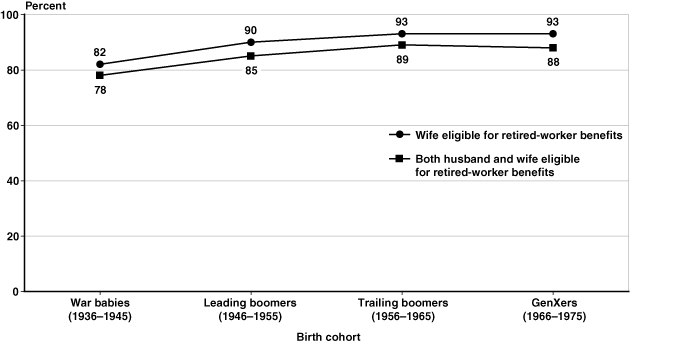
| Birth cohort | Wife eligible for retired-worker benefits | Both husband and wife eligible for retired-worker benefits |
|---|---|---|
| War babies (1936–1945) | 82 | 78 |
| Leading boomers (1946–1955) | 90 | 85 |
| Trailing boomers (1956–1965) | 93 | 89 |
| GenXers (1966–1975) | 93 | 88 |
Social Security benefits depend on a married woman's earnings, as well as on how her earnings compare with those of her husband. Consistent with what other researchers have found, MINT6 projects that spouse lifetime earnings are positively correlated and that correlation will become stronger over time (Chart 4). For example, the correlation of spouse lifetime earnings (AIME) is 0.16 for war baby wives, increasing to 0.17 for leading boomer wives, 0.20 for trailing boomer wives, and 0.25 for GenX wives.
Correlation between husbands' and wives' projected average indexed monthly earnings, by birth cohort
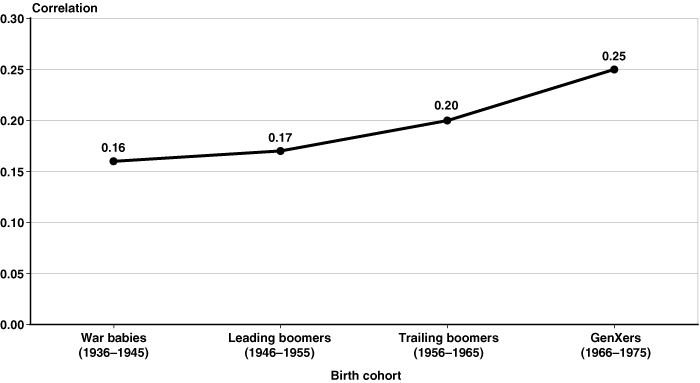
Because spouses' earnings are expected to become even more similar over time, MINT6 projects that fewer wives will be eligible for auxiliary benefits based on their husbands' earnings. Among the war baby wives shown in Chart 5, 18 percent will receive a Social Security benefit based entirely on their husbands' earnings (auxiliary only), and 27 percent will receive a Social Security benefit based in part on their husbands' earnings (dually entitled). In total, 45 percent of war baby wives will receive auxiliary Social Security benefits when they claim them. Among GenX wives, only 25 percent will receive auxiliary benefits when they claim them. Just 7 percent of GenX wives will receive only auxiliary benefits, while 18 percent of them will receive both retired-worker and auxiliary benefits. The closing gap between spouses' earnings is also reflected in the share of married women projected to receive only retired-worker benefits at Social Security take-up. Among war babies, 55 percent of wives will receive only a retired-worker benefit based on their own earnings because that benefit is larger than the auxiliary benefit based on their husbands' earnings. In other words, over half of the wives in the war baby cohort have earnings that are too high relative to their husband's earnings to qualify for auxiliary benefits. Over time, the size of the retired-worker-only population of married women is projected to increase by 20 percentage points to 75 percent of GenXers.
Projected Social Security benefit status of married women at Social Security take-up age, by birth cohort
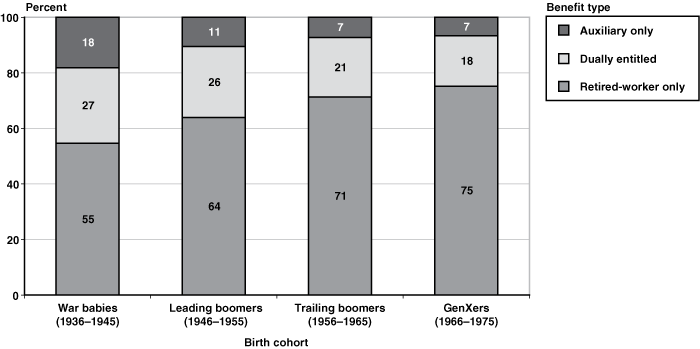
| Birth cohort | Benefit type | ||
|---|---|---|---|
| Auxiliary only | Dually entitled | Retired-worker only | |
| War babies (1936–1945) | 18 | 27 | 55 |
| Leading boomers (1946–1955) | 11 | 26 | 64 |
| Trailing boomers (1956–1965) | 7 | 21 | 71 |
| GenXers (1966–1975) | 7 | 18 | 75 |
While her husband is alive, a wife is eligible for an auxiliary benefit if her own retired-worker benefit is less than 50 percent of her husband's retired-worker benefit. If her husband dies, the same woman is eligible for an auxiliary benefit if her own retired-worker benefit is less than 100 percent of her husband's retired-worker benefit. The women who meet those criteria will receive higher benefits as widows.6 Chart 6 compares the projected benefits of married women when their husbands are alive and after they die. Married women in the war baby cohort are expected to receive average monthly benefits of $1,028 as spouses and $1,560 as widows, in 2011 dollars (before any actuarial adjustments for early or delayed retirement). As women's earnings increase over time, their Social Security benefits will also increase. So it is not surprising that married women in the GenX cohort are projected to receive higher average monthly benefits ($1,551 as spouses and $2,040 as widows) than their war baby counterparts. Although the average married woman will get a higher Social Security benefit as a widow than as a wife, not all married women can expect larger benefits when their husbands die. Married women whose retired-worker benefits are higher than their husbands' retired-worker benefits will not be eligible for widow benefits based on their husbands' earnings. Those women will see no change in their Social Security benefits when their husbands die. MINT6 projects that 82 percent of war baby wives will receive higher benefits as widows than as spouses—meaning that an additional 18 percent of those women will see no change in their benefits when their husbands die. As women's earnings increase over time, married women are more likely to have higher earnings (and consequently higher retired-worker benefits) than their husbands and are therefore less likely to receive widow benefits. Reflecting this trend, MINT6 projects that only 66 percent of GenX wives will receive higher benefits as widows than as spouses.
Projected mean monthly Social Security benefits of married women at Social Security take-up age before and after their husbands die and percentage of women who will receive higher benefits as a survivor, by birth cohort
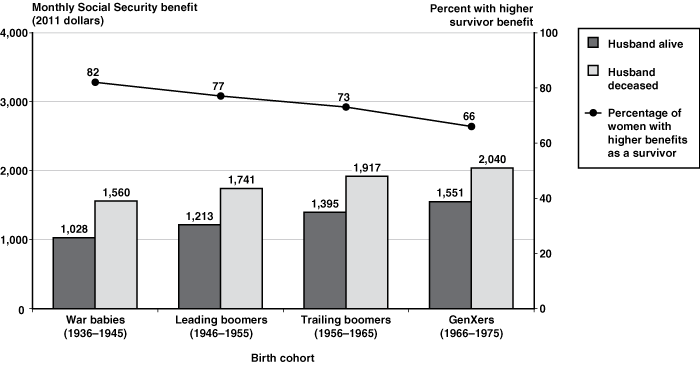
| Birth cohort | Monthly Social Security benefit (2011 dollars) | Percentage with higher benefits as a survivor |
|
|---|---|---|---|
| Husband alive |
Husband deceased | ||
| War babies (1936–1945) | 1,028 | 1,560 | 82 |
| Leading boomers (1946–1955) | 1,213 | 1,741 | 77 |
| Trailing boomers (1956–1965) | 1,395 | 1,917 | 73 |
| GenXers (1966–1975) | 1,551 | 2,040 | 66 |
Another way to understand how the changes in spouses' earnings might impact the Social Security benefits of married women is to simulate benefits (1) based only on their husbands' earnings, (2) based only on their own earnings, and (3) to compare those benefits with actual benefits based on both spouses' earnings. Table 1 shows projected average Social Security benefits (before any actuarial adjustment) using three computation methods. The first row shows the average benefit a wife receives based on her retired-worker benefit and any auxiliary benefit she may be entitled to as a spouse. The next two rows show the average benefit a wife would receive if that benefit was computed using only her husband's lifetime earnings and the share of the actual benefit it represents. This simulation essentially assumes that the wife does not work and that she is ineligible for retired-worker benefits. The last two rows of the table show the average benefit a wife would receive if that benefit was computed using only her own lifetime earnings and the share of the actual benefit it represents. This simulation assumes the wife's retired-worker benefit is larger than any auxiliary benefit she could receive based on her husband's earnings and that she is ineligible for auxiliary benefits.
| Computation method | War babies (1936–1945) |
Leading boomers (1946–1955) |
Trailing boomers (1956–1965) |
GenXers (1966–1975) |
|---|---|---|---|---|
| Actual benefit a | 1,028 | 1,213 | 1,395 | 1,551 |
| Using only husband's earnings b | ||||
| Simulated benefit | 736 | 811 | 878 | 910 |
| Share of actual benefit (%) | 72 | 67 | 63 | 59 |
| Using only wife's earnings c | ||||
| Simulated benefit | 833 | 1,060 | 1,276 | 1,444 |
| Share of actual benefit (%) | 81 | 87 | 91 | 93 |
| SOURCE: Authors' calculations using MINT6 data. | ||||
| NOTE: Sample includes married women in the year they claim Social Security benefits, but excludes those women projected to ever receive Social Security Disability Insurance benefits. | ||||
| a. Defined as the wife's Social Security benefit, which is based on both the husband's and wife's earnings. That amount is derived by comparing the wife's PIA with her husband's PIA. If the wife's PIA is less than one-half of her husband's PIA, then the amount of Social Security benefit she receives is effectively equal to one-half of her husband's PIA. This is the Social Security benefit the wife would receive before any actuarial reductions for early retirement or increases for delayed retirement. | ||||
| b. Computed as one-half the husband's PIA, which is based on the husband's earnings. | ||||
| c. Defined as the wife's PIA, which is based on the wife's earnings. | ||||
The results show that average benefits based on just the husband's earnings are less than actual benefits because many wives do work and will receive retired-worker benefits based entirely on their own earnings. However, average benefits based just on the wife's earnings are also less than actual benefits because many wives will still receive auxiliary benefits.
Average benefits based just on the husband's earnings are projected to increase from $736 to $910 between the first (war baby) and last (GenX) cohorts, which is a decline from 72 percent of the actual benefit for war baby wives to only 59 percent of the actual benefit for GenX wives. This result suggests that over time, married women's actual benefits are decreasingly likely to be based entirely on their husbands' earnings. Average benefits based just on the wife's earnings are projected to increase from $833 to $1,444 between cohorts, which is an increase from 81 percent of the actual benefit for war baby wives to 93 percent of the actual benefit for GenX wives. This finding suggests that over time, married women's actual benefits are increasingly likely to be based entirely on their own earnings.
Conclusions
In this article, we consider how changes over time in the earnings of couples will impact married women's Social Security benefits. Historical trends show dramatic increases over time in women's labor force participation and earnings and a declining earnings gap between men and women. These trends will significantly reduce the share of married women projected to receive auxiliary Social Security benefits at retirement and will reduce the level of auxiliary benefits for married women who are projected to receive them.
Compared with war baby wives, a larger share of wives in later cohorts will be eligible for Social Security benefits based solely on their own earnings. Their rising earnings will increase wives' average Social Security benefits by 50 percent over the next 30 years. Despite rising female lifetime earnings, wives' earnings typically remain below those of their husbands, so many wives who are retired-worker-only beneficiaries while their husbands are alive will receive auxiliary benefits when their husbands die.
The Social Security provisions that pay auxiliary benefits to wives and widows were intended to increase adequacy, particularly important for early cohorts of women with little or no lifetime earnings (Berkowitz 2002). As earnings of husbands and wives have become more equal over time, the impact of those provisions will decline. Still, about one-fourth of GenX wives and two-thirds of GenX widows are expected to receive auxiliary benefits at retirement. As Congress seeks ways to reform Social Security to address insolvency, changes to the auxiliary benefit provisions—in the face of dramatic shifts in men's and women's earnings—should be considered.
Notes
1 The 1983 Amendments to the Social Security Act gradually increased the FRA from 65 to 67. Beginning with persons born in 1938 (who turned age 62 in 2000), the FRA increased 2 months a year until it reached 66 for those born in 1943 (who turned age 62 in 2005). The FRA remains at this level for the next several years. It begins increasing 2 months per year again for persons born in 1955 (and turning age 62 in 2017), until it reaches 67 for those born in 1960 and later.
2 Unless the spouse's Social Security benefit is reduced for early retirement or increased for delayed retirement.
3 MINT6 also projects income from pensions, assets, Supplemental Security Income, other transfer income, income of coresident household members, and imputed rent. Those income sources, however, are not analyzed in this article.
4 The baby boom cohort is typically represented as persons born from 1946 through 1964. For analytical purposes, however, we define the baby boom cohort as those born from 1946 through 1965.
5 Social Security take-up age for married women varies between ages 62 and 70 depending on individuals' take-up decisions. MINT6 assumes that all eligible individuals take-up benefits by age 70, after which delaying take-up does not increase benefits.
6 This benefit, however, will be less than the total benefit the couple would have received when the husband was alive, which is one reason why poverty rates among older widows are so high.
References
Berkowitz, Edward. 2002. "Family Benefits in Social Security: A Historical Commentary." In Social Security and the Family, edited by Melissa Favreault, Frank Samartino, and Eugene Steuerle, 19–46. Washington, DC: Urban Institute Press.
Blau, Francine D., and Lawrence M. Kahn. 2007. "Changes in the Labor Supply Behavior of Married Women: 1980–2000." Journal of Labor Economics 25(3): 393–438.
Bureau of Labor Statistics. 2011. "Labor Force Statistics from the Current Population Survey." Washington, DC: Department of Labor. http://data.bls.gov/pdq/querytool.jsp?survey=ln.
Census Bureau. 1981. Household and Family Characteristics: March 1980. Current Population Reports, Series P-20, No. 366. Washington, DC: Government Printing Office.
———. 2010. America's Families and Living Arrangements: 2010. Washington, DC: Census Bureau. http://www.census.gov/population/www/socdemo/hh-fam/cps2010.html.
———. 2011. Statistical Abstract of the United States, 2011: The National Data Book. Washington, DC: Census Bureau.
Devereux, Paul J. 2004. "Changes in Relative Wages and Family Labor Supply." Journal of Human Resources 39(3): 698–722.
Goldin, Claudia. 2006. "The Quiet Revolution That Transformed Women's Employment, Education, and Family." American Economic Review 96(2): 1–21.
Sandell, Steven H., and Howard M. Iams. 1997. "Reducing Women's Poverty by Shifting Social Security Benefits from Retired Couples to Widows." Journal of Public Policy Analysis and Management 16(2): 279–297.
Schwartz, Christine. 2010. "Earnings Inequality and the Changing Association between Spouses' Earnings." American Journal of Sociology 115(5): 1524–1557.
Smith, Karen E., David B. Cashin, and Melissa M. Favreault. 2005. Modeling Income in the Near Term 4. Final report to the Social Security Administration. Washington DC: Urban Institute Press. http://www.urban.org/UploadedPDF/411191_MINT4.pdf.
Smith, Karen E., Melissa M. Favreault, Barbara A. Butrica, and Philip Issa. 2010. Modeling Income in the Near Term, Version 6. Final report to the Social Security Administration. Washington, DC: Urban Institute Press.
Smith, Karen E., Melissa M. Favreault, Caroline Ratcliffe, Barbara Butrica, Eric Toder, Jon M. Bakija. 2007. Modeling Income in the Near Term 5. Final report to the Social Security Administration. Washington, DC: Urban Institute Press.
[SSA] Social Security Administration. 2010. Income of the Population 55 or Older, 2008. Washington, DC: SSA. http://www.socialsecurity.gov/policy/docs/statcomps/income_pop55/2008/index.html.
———. 2011. Annual Statistical Supplement to the Social Security Bulletin, 2010. Washington, DC: SSA.
Sweeney, Megan M., and Maria Cancian. 2004. "The Changing Importance of White Women's Economic Prospects for Assortative Mating." Journal of Marriage and Family 66(4): 1015–1028.